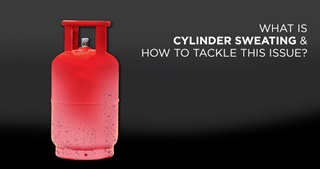LPG Cylinder Sweating: Causes and Safe Practices

Though this is a common sense, it does have some real implications. But what causes this "cylinder sweating," and is it something to worry about?
Understanding why it happens is crucial for maintaining safety and efficiency in your commercial kitchen. Let’s break down the science behind LPG cylinder sweating, and, most importantly, discuss what it means for safety and how to manage it effectively.
Naturally LPG is stored in liquid form and is converted to gas allowing it to be used in appliance and stoves. When LPG moves from liquid to vapor state inside the cylinder, it absorbs heat from its surroundings. When the cylinder loses heat, it gets cold. This causes moisture in the air to condense on the cold surface, forming water droplets or even ice. These droplets or even ice in extreme conditions on the surface of the cylinder is called “sweating”.
Is cylinder sweating normal? A little bit of condensation is usually not a problem. However, if you see a lot of water or ice, or if it happens frequently, it could mean that:
For best cylinder performance and efficiency, choose a supplier with a deep understanding of your usage patterns, high-quality LPG installation systems, and strong technical expertise. SUPERGAS stands out as a reliable supplier with top-quality installations with certified equipment, regular safety inspections and maintenance and hands-on training for your team, you can optimise your LPG usage while ensuring safety and efficiency.
To answer the most important question; is gas cylinder sweating dangerous?
A little bit of sweating is usually nothing to worry about. However, it does:
While not immediately dangerous, sweating indicates an imbalance in gas usage. Do not try to fix the problem by yourself.
What NOT to do:
Using unsafe methods to prevent or stop it can create serious safety hazards. Try to observe and understand your usage volumes and patters.
What to do:
For further information on understanding and accessing your LPG needs, queries related to manifold installation, or a new connection with SUPERGAS - contact your nearest franchisee or reach out to your supplier.